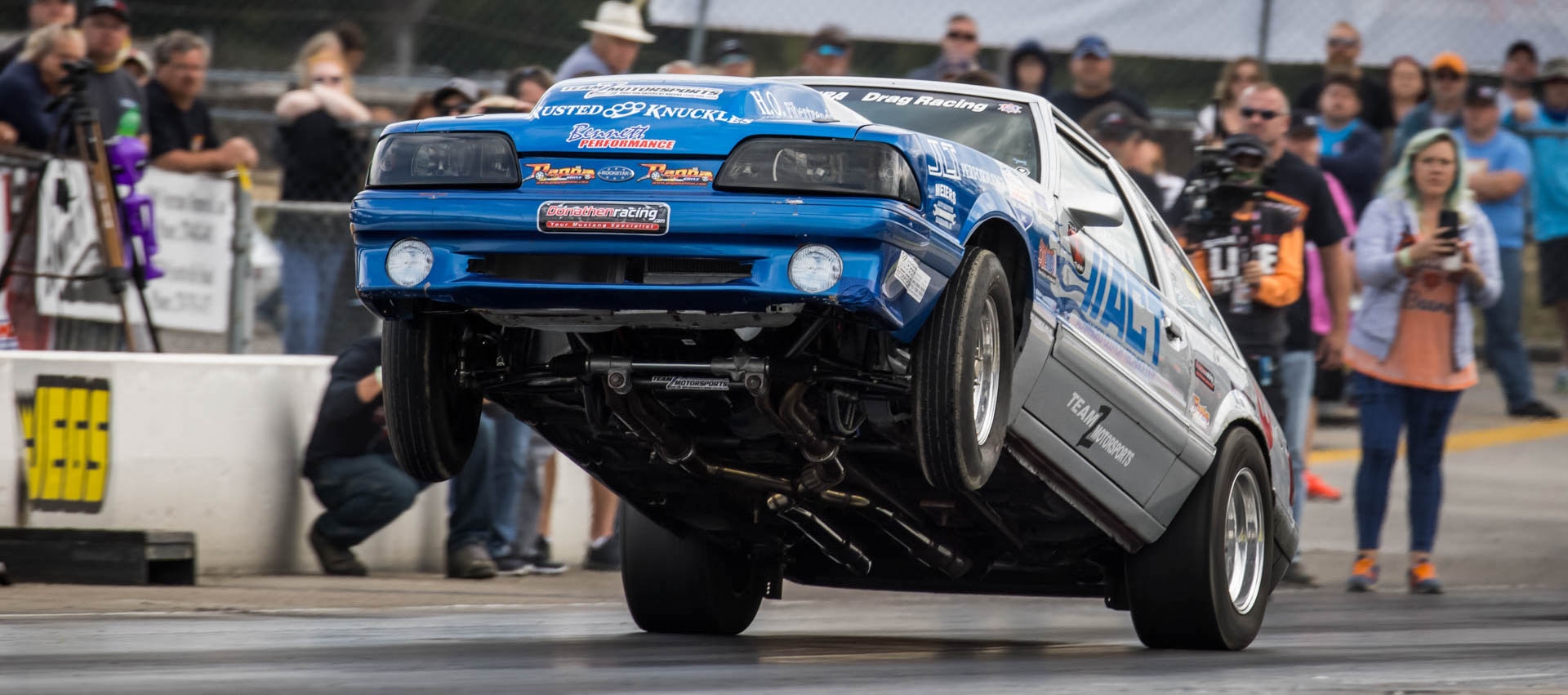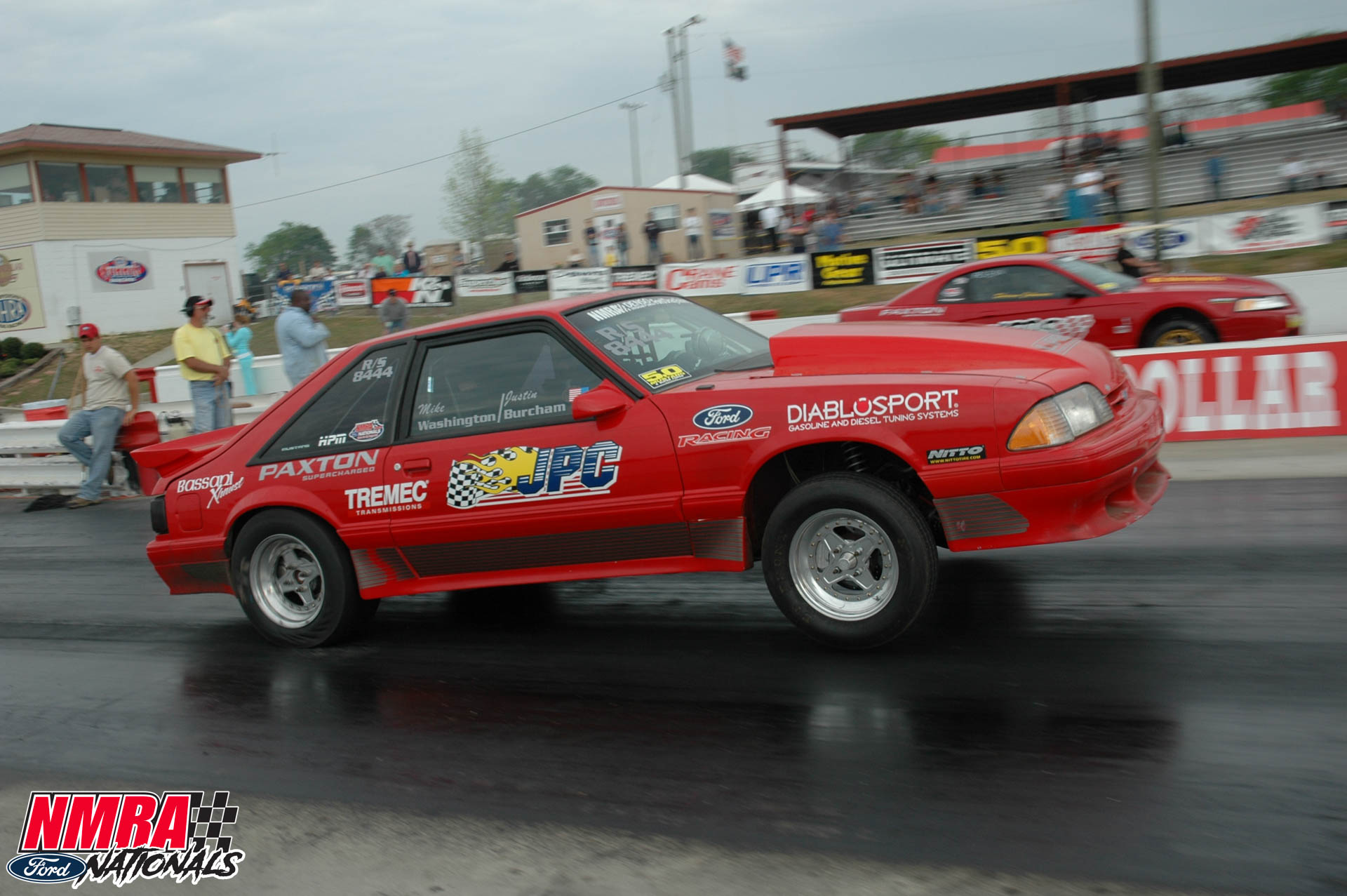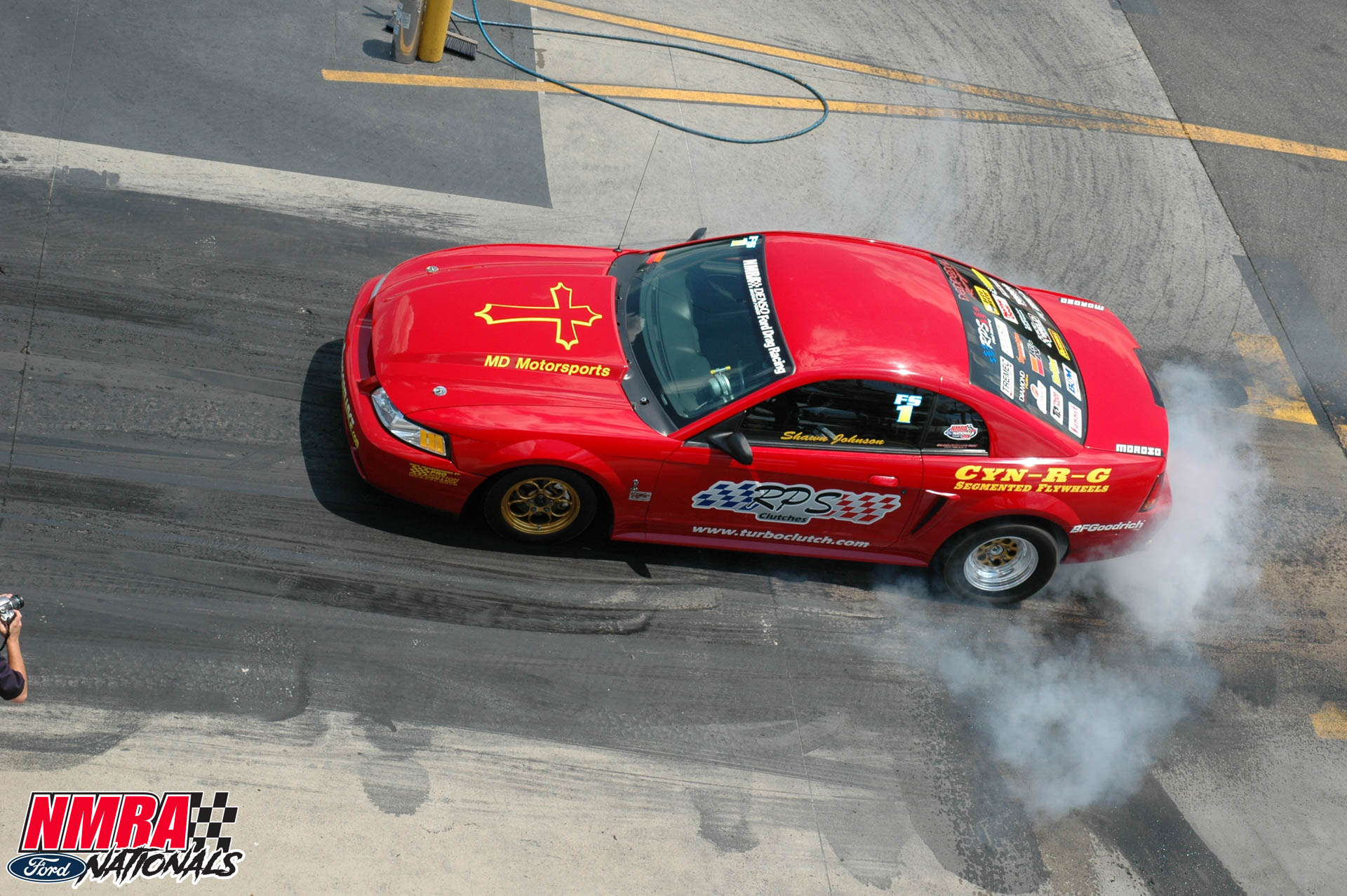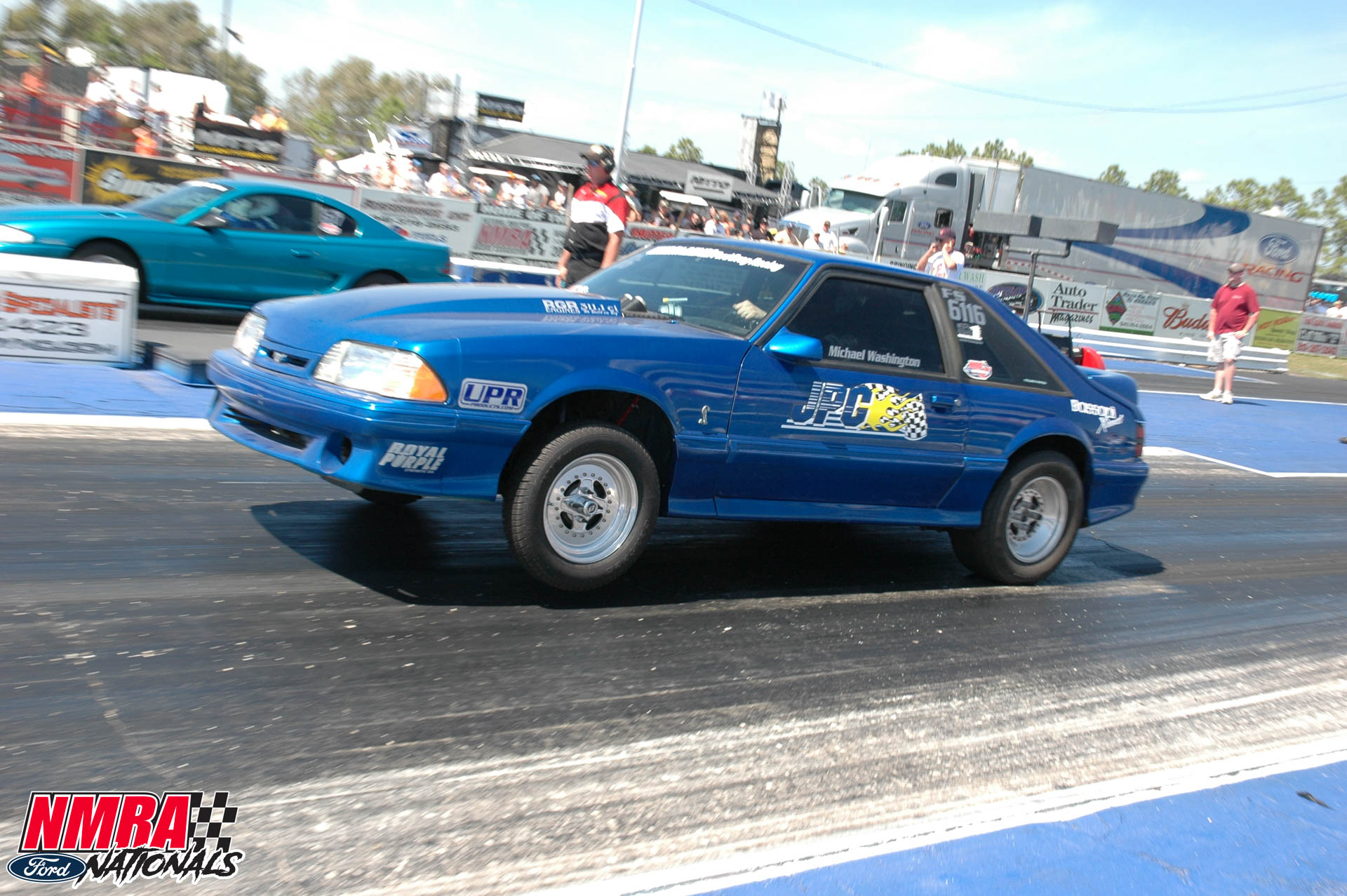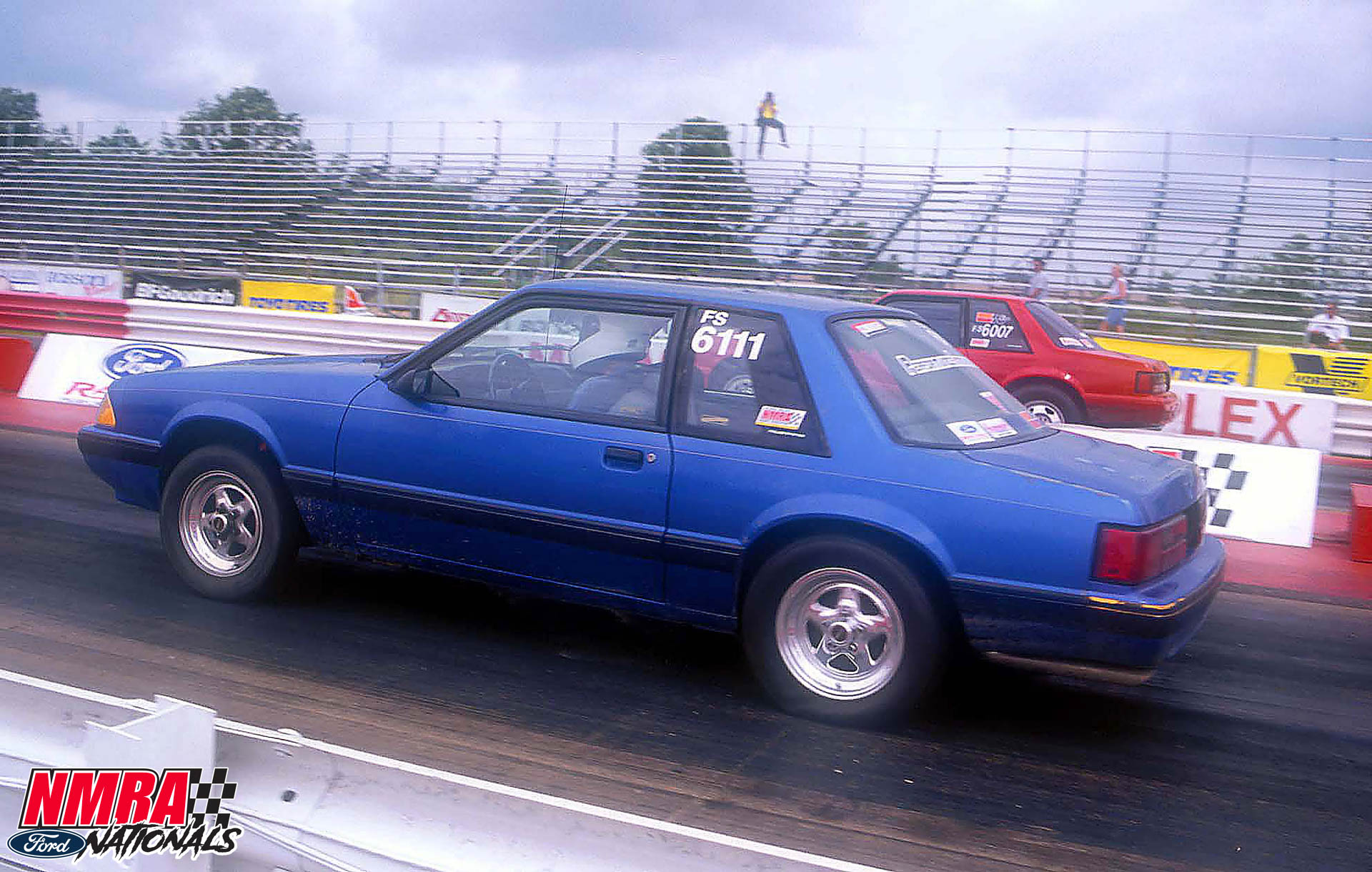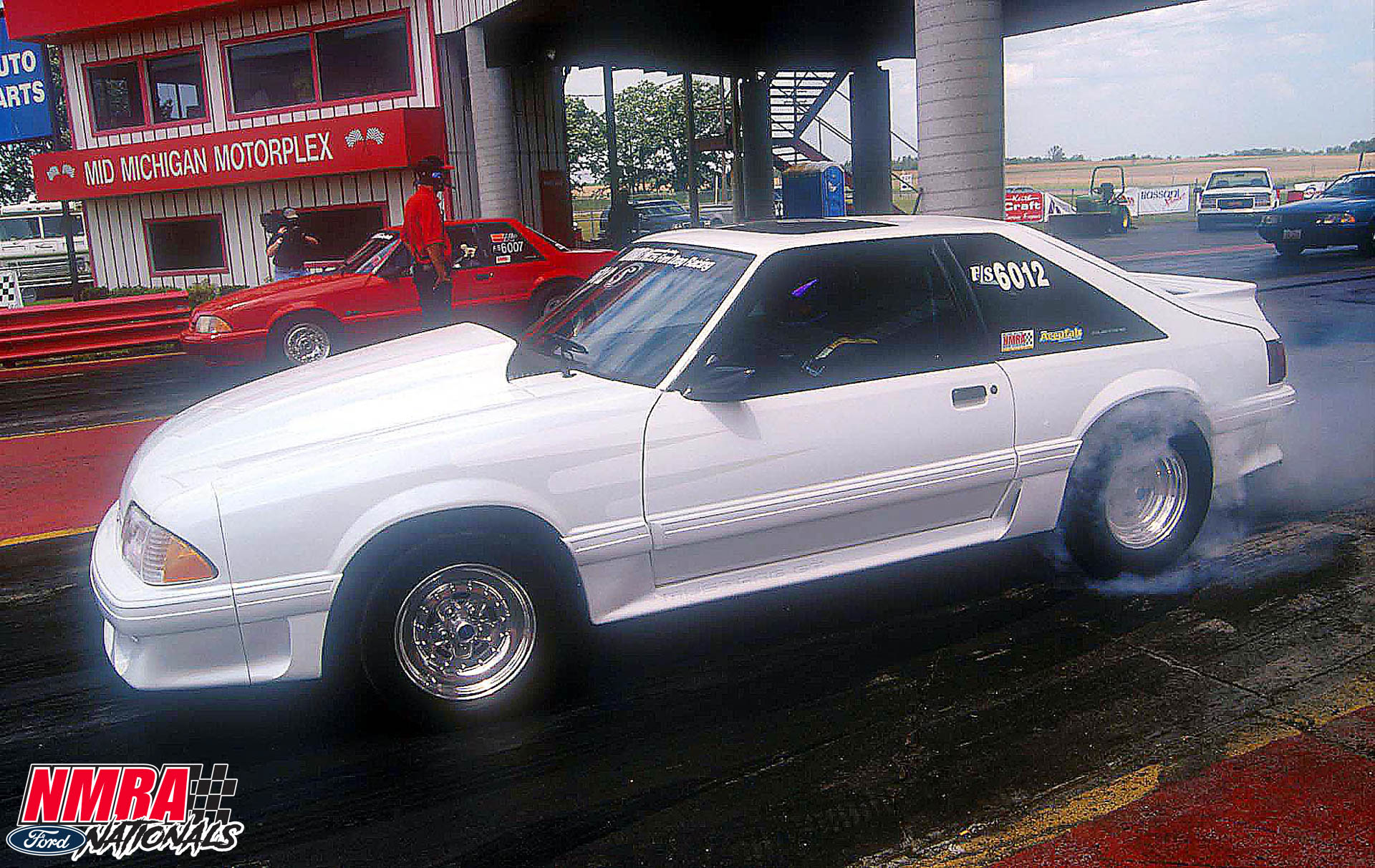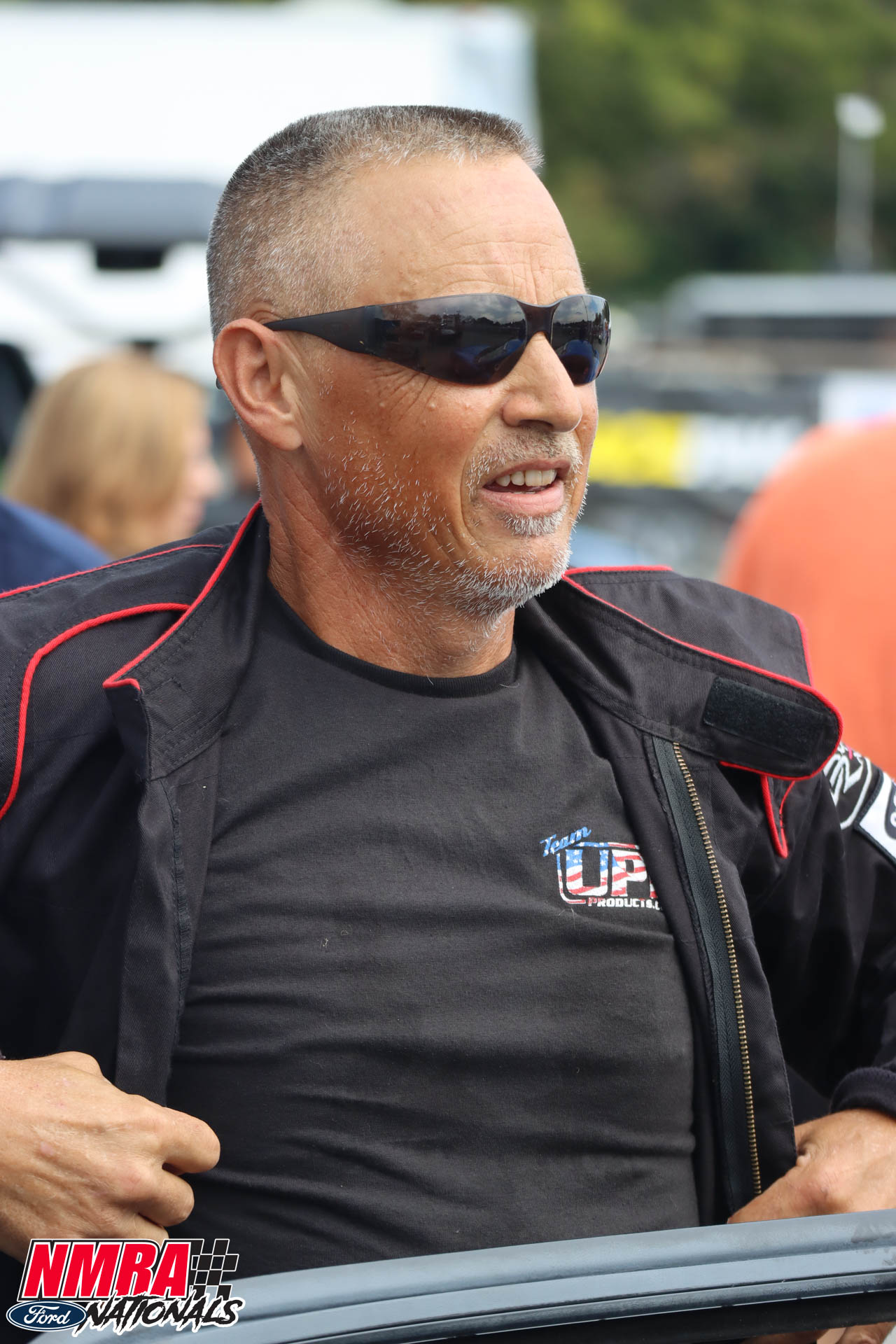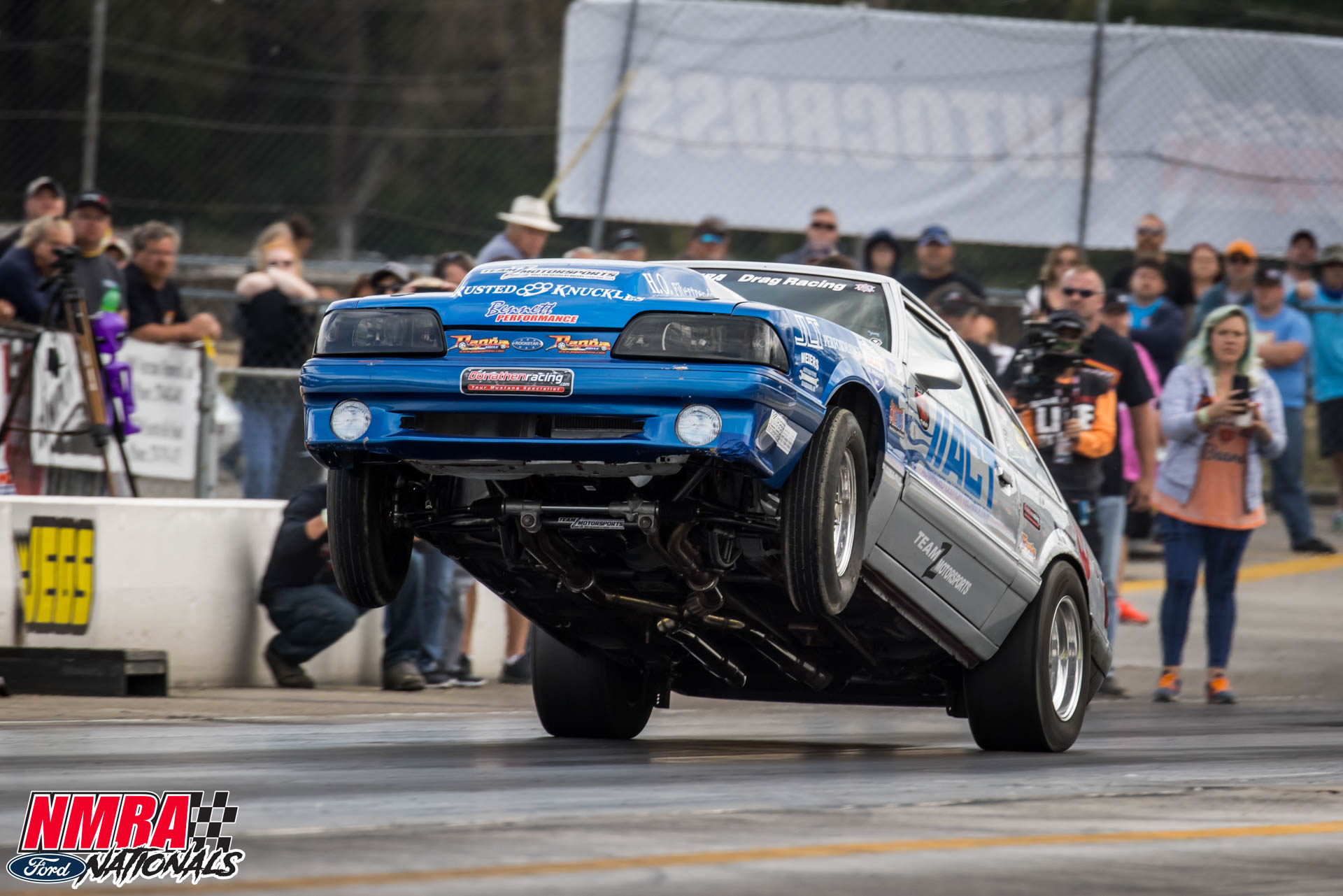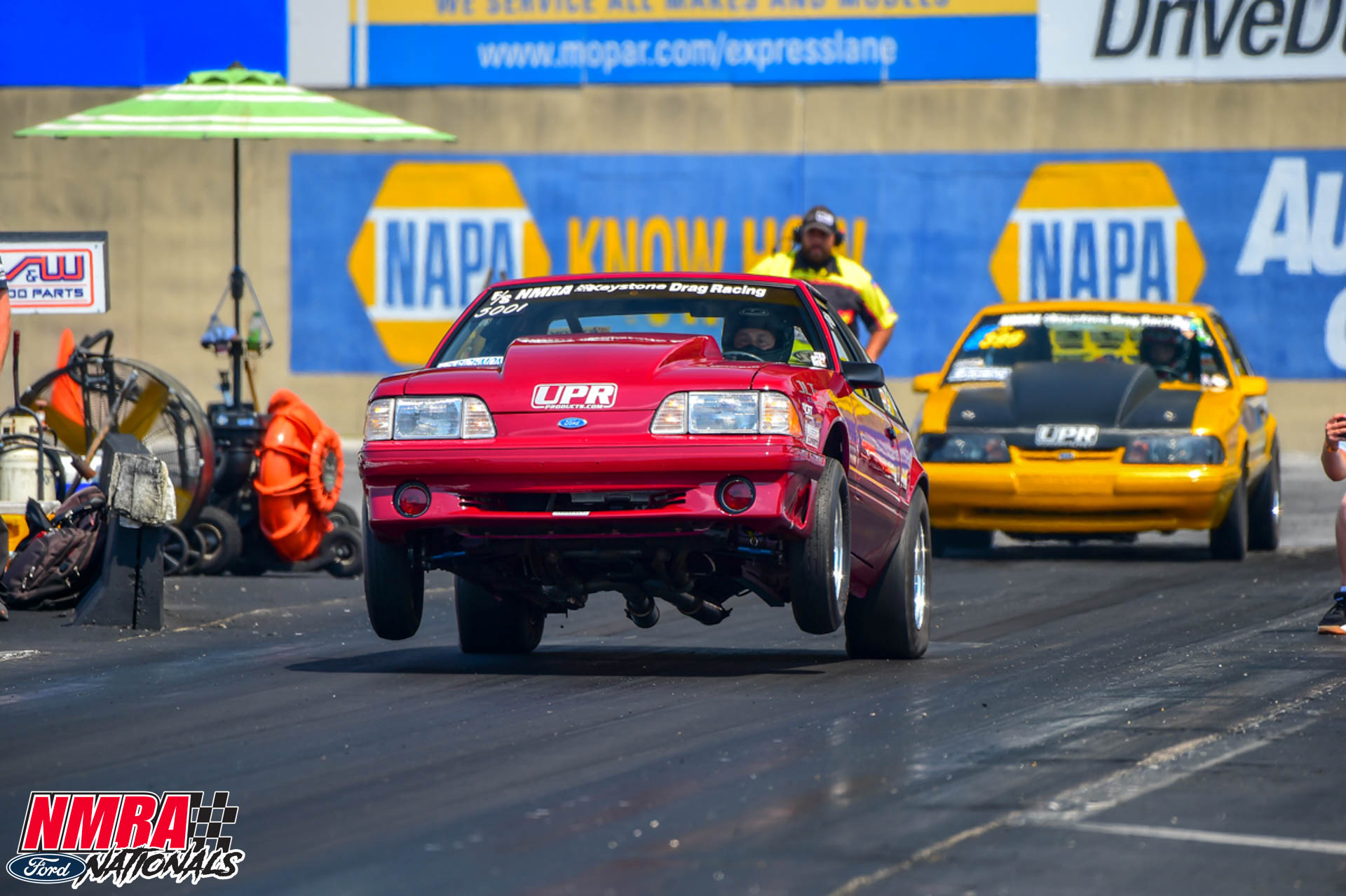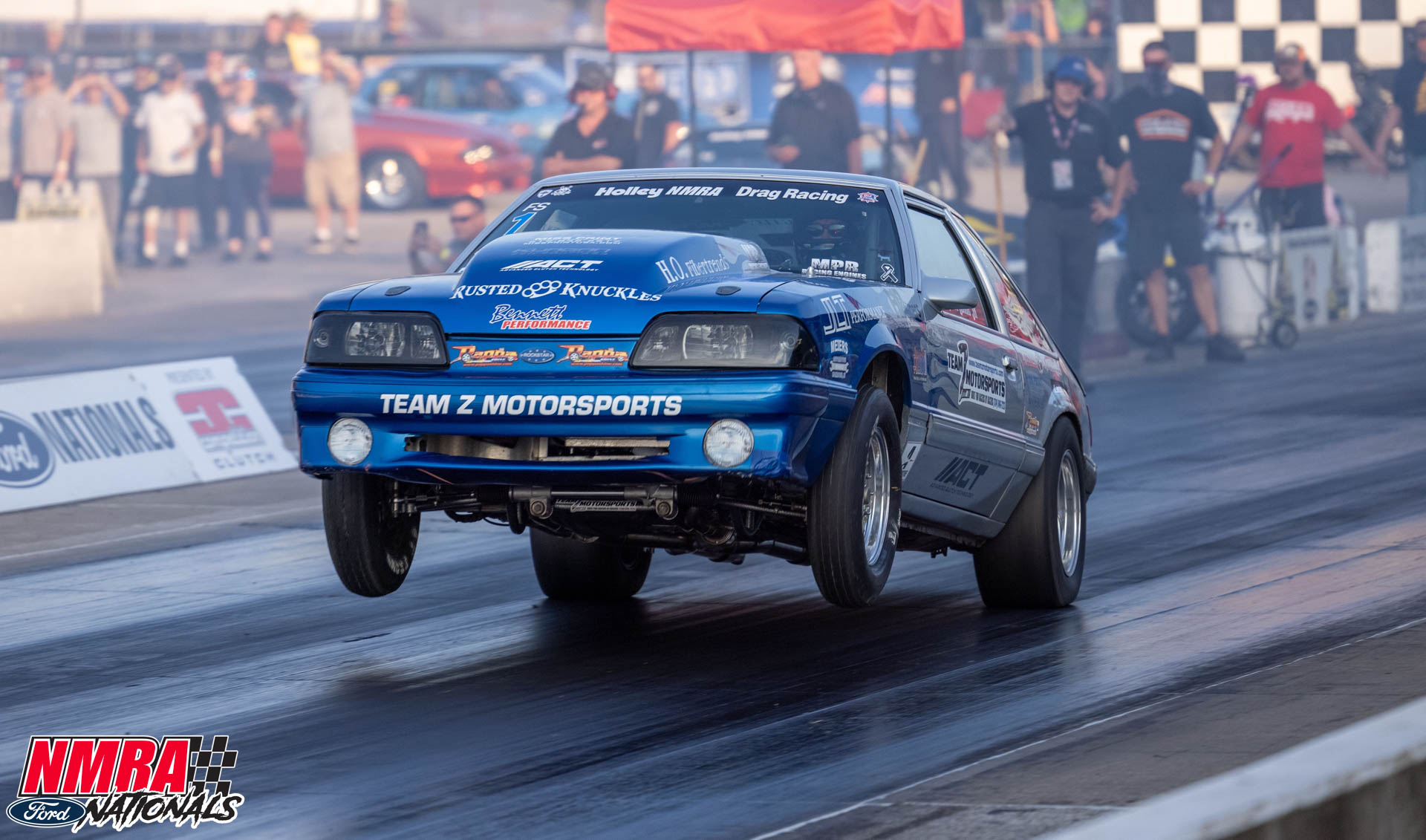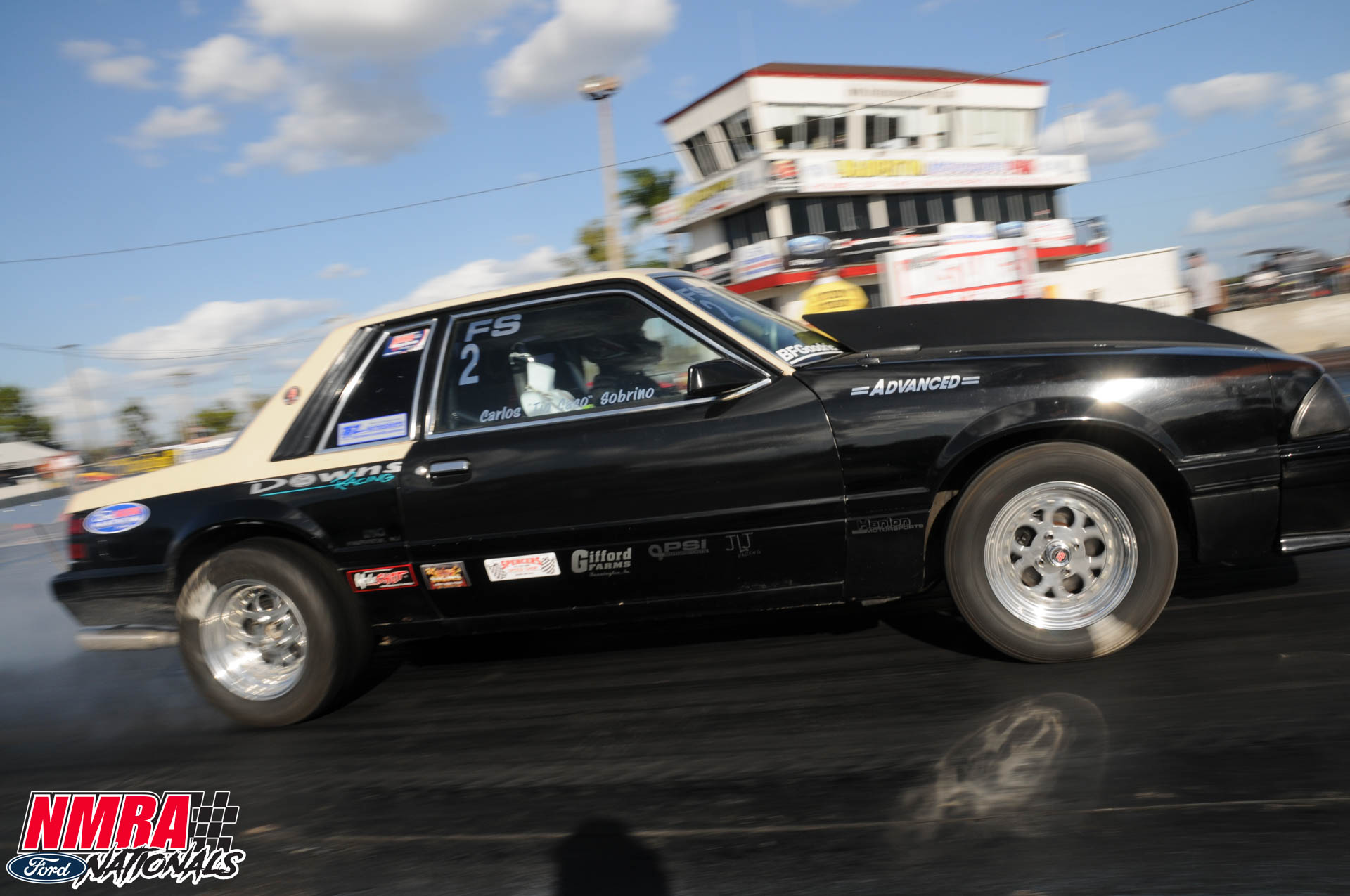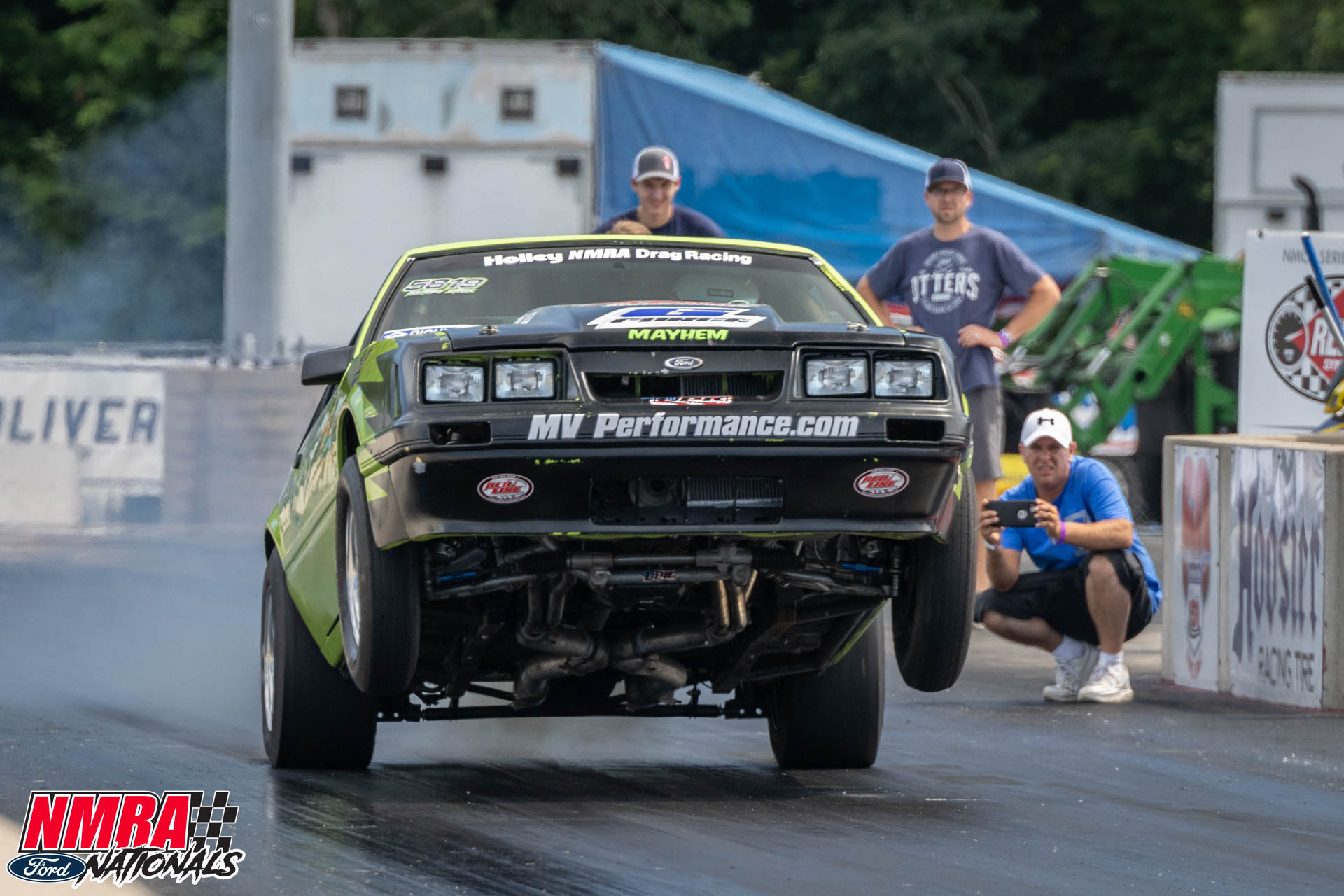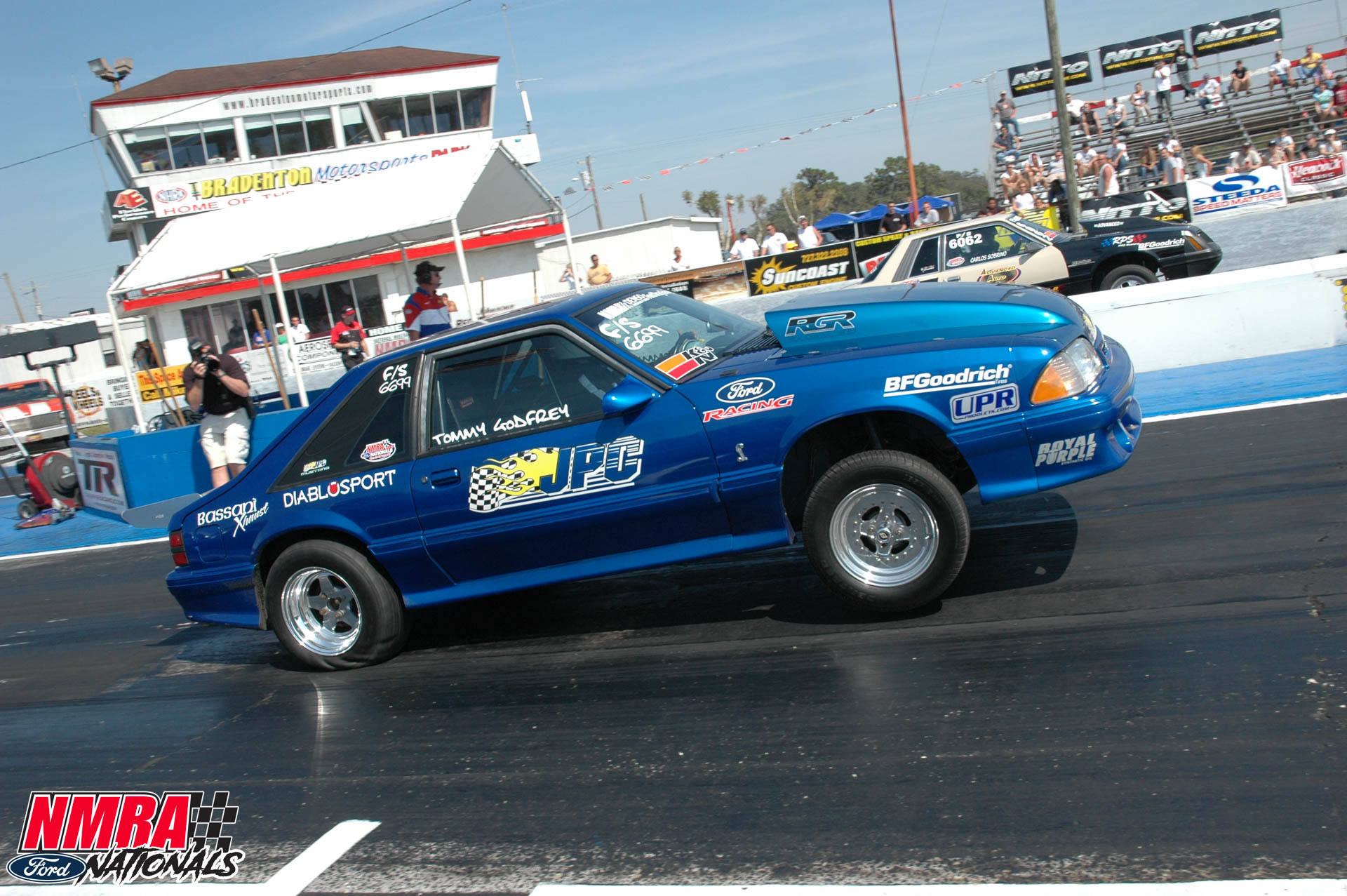Factory Stock Flashback—Hotly debated for decades, this driver’s class is one of NMRA’s longest-running categories
Written by Ainsley Jacobs
Photography by the FSC staff and courtesy of Keplinger Designs
With strict restrictions on what can and cannot be modified, NMRA’s Richmond Gear Factory Stock class is one of the sanctioning body’s most challenging categories. With a history spanning the entire duration of the series, having started in 1999 and running continuously ever since, Factory Stock has seen its share of dreams come true and drama unfold over the years.
In light of NMRA’s silver anniversary season, it seems fitting to look back on this OG entry-level class.
Designed for 1954 and newer Ford-bodied vehicles with naturally aspirated 4.6-, 5.0-, and 5.0-liter Gen 1 and Gen 2 Coyote engines maxing out at a displacement of 315 cubic inches, the class is contested as an all-run, heads-up field with a .400 pro tree. Additionally, with only NMRA-specified Ford OEM automatic or specific aftermarket manual transmissions permitted, Factory Stock is widely known as a driver’s class where skill is just as crucial as car setup.
In just its second season ever, NMRA Factory Stock saw Joffre LaFontaine take the season championship as well as the elapsed time record when he ran 12.769 seconds in the quarter mile; Gabe Large set the speed record with his trap of 111.670 mph.
Early on, almost everyone in the class had been running a manually shifted gearbox, but Rich Groh, of RGR Engines fame, shook things up in 2001 by competing with an automatic transmission. Groh showed what was possible with the unconventional and earned championship honors as a result.
By 2002, though, the class’s quickest elapsed time dropped by a full second as JPC Racing’s main man Justin Burcham reset both ends of the record with his run of 11.720 seconds and speed of 115.540 mph. Unsurprisingly, Burcham also secured the championship that same season.
The following year, another JPC Racing team member made waves in Factory Stock as Mike Washington dominated the class. “You can call it ‘JPC Stock’ because we have won more races and championships than anyone else,” laughed Washington with his typical joking nature. “At one point, we won 18 races in a row over three years.”
Washington began in Factory Stock alongside Burcham in 2001. He purchased the car that Robin Lawrence campaigned in 2002 to race in 2003, and dialed in the Mustang’s setup to do business.
“In 2003, I was the number-one qualifier at every event and went to the final round at every race,” recalled the man. Until then, no one ever had a perfect season and Washington was on track to make history — with two records to his name as well, having run 11.82 seconds and 114.07 mph. “In the final round at Bowling Green, [Kentucky], I was out on Jamie [Holten], I put it in fourth gear, and the clutch pedal stuck to the floor. I was basically in neutral as I watched him drive past me.”
The defeat was bittersweet for Washington, who enjoyed a high point in his career as he took the Factory Stock championship title but lost the chance to have the first NMRA perfect season by going out in the final round of the final race. “The NMRA also ran in Texas that year, so I am the only Factory Stock racer to have ever won in Texas,” added Washington, proud of his supplemental claim-to-fame.
The Four-Valve modular engine took center stage in 2004, as Bob Cosby came in and won with what was “essentially a street car compared to the rest of us,” according to Washington. Cosby pushed his Four-Valve, 4.6-liter Mod motor to the front of the pack over and over and ushered in a new era of Factory Stock competition. It was Shawn Johnson, though, who held the records that year with his 11.41-second run and a trap speed of 119.07 mph.
Running on the class-spec BFG drag radial tire leveled the playing field, as many races were won or lost by how well the pilot handled his clutch. With somewhat limited traction technology, the BFG radial rubber forced racers to tinker with and test their setups, refining them for the best results.
“You didn’t know if the tire would hook or spin, especially since track prep isn’t what it is now,” noted Washington of how the racing surface wasn’t nearly as well-manicured as it is in modern times, thanks to companies like Kurt Johnson’s Total Venue Concepts. “Back then, they would basically rub some gold dust on the track, send ‘em, and hope for the best.”
Next, back-to-back season championships went to Johnson, impressively, in 2005 and 2006, but it was Tommy Godfrey who came in like a wrecking ball in 2007 to set the record for the number of championships earned by a racer in the category.
At his first race in his first season of Factory Stock, Godfrey won the opening event outright behind the wheel of Washington’s blue Fox Mustang. “Everyone thought I was cocky for being the new guy and talking smack online and saying I’d show up to Florida and win, but I did exactly that,” he laughed. Godfrey followed up the performance with two runner-up finishes, then ended his year with a number-one qualifying performance and yet another runner-up. Overall, it was enough to place the rookie at the top of the championship points standing.
“The mod motors had evolved a little bit between the early 2000s to where I came in, but when I came in, the Two-Valves had caught up,” recalled the driver who later raced his own orange 1989 Ford Mustang coupe. “The pushrod rules had been the same, but the cars got quicker with better technology and through testing.”
With 311 cubic inches of potent Rich Groh Racing-built power under the hood, Godfrey opted to switch from his GT40-style cylinder heads to the Ford E7 heads at the end of his first season to take advantage of a weight break option but returned to the GT40 set by 2010.
Also using a G-Force T5 transmission with a Centerforce dual-friction clutch, Godfrey often tested out different off-the-shelf pressure plates to see what would work best. “There wasn’t anything trick or magical about it,” noted the successful racer. “I learned to slow the clutch speed down with my leg to where it would pre-load the clutch and suspension and not hit the tire too hard at the launch.”
Although suspension setup was important, the early Factory Stock days had simple rules for fairly stock systems. Power steering was mandatory, no upgraded rear anti-roll bars, no coilovers were permitted, and other mandates meant guys like Godfrey would upgrade only a few odds and ends but nothing else. “I had UPR upper and lower control arms and Moroso Trick Coil springs, but it was pretty basic,” he confirmed. “It had drum brakes on it, too, and it still does today.”
Godfrey’s success was unprecedented, however, as the man from Maryland wound up winning four Factory Stock championship titles overall, straight through from 2007 to 2010. “It was cutthroat and I raced against a bunch of great guys,” shared Godfrey, who moved on from Factory Stock to Pure Street after his fourth and final season. “The key to my success was just testing everything, a lot. I spent a ton of time figuring out how to drive the car, how to leave better, and working on consistency.”
In his final season of the class, the 2010 year, Godfrey was the first in Factory Stock history to run a 10-second quarter-mile. His 10.964 at 122.24 mph trip in qualifying at the NMRA season opener in Florida gave him the official bragging rights, but Godfrey went even further when he ran 10.89 and 122.59 mph during the weekend before winning the entire ordeal.
Following Godfrey’s reign, it was Carlos Sobrino who clinched dual championships in both 2011 and 2012. The class remained on the cusp of the 10-second zone, hovering back and forth between high-10 and low-11-second passes for a few years, but settled into the 10-second zone more consistently by then.
In 2013, 11-second timeslips were undeniably a thing of the past for the quickest in the field, and Chris Lee earned the title of class champion for the year. Matt Amrine earned three of his own in 2013, 2015, and 2017 with James Meredith having intercepted the honors in 2016. As always happens, the class inched lower and lower in the 10-second field until 10.3- and 10.4-second runs were the norm by 2018 and 2019. In both years, longtime NMRA racer Dan Ryntz capitalized on points.
Showing an incredible amount of drive and tenacity, the 2020 NMRA Factory Stock season championship went to John Leslie, Jr. The man from Indiana raced in the class for two decades before earning his first title, and the wait was well worth it.
“I had been racing World Ford Challenge in the mid-to-late ‘90s and got interested in heads-up racing,” recalled Leslie, who read the NMRA rulebook and realized that his red Ford Mustang notchback fit the Factory Stock class. “It was basically a street car with bolt-ons.”
In his early 20s at the time, Leslie had a blast running at a grassroots level with whatever he could scrape together. “I drove to the races. My mom bought me my first set of drag radials, and I had a jack, a toolbox, a sleeping bag, and a tent,” he remembered of his early days. It didn’t take long for Leslie to realize the problem with his arrangement should some critical component break, though, and he soon purchased a Ford F-150 pickup and an open trailer.
Leslie watched Factory Stock evolve from its humble beginnings to its more modern racecar-style era. “We had big car counts and the class was hopping. It was a challenge just to make the 16-car field for eliminations,” he stated. “Unfortunately, the recession of 2008-2009 really hurt the class as fuel prices spiked and the cost of racing skyrocketed.”
His willingness to stick it out through the tough times yielded big dividends, though. “Over the years, there had always been something that hampered our efforts and I came so close to winning the championship,” said Leslie, who finally made it happen in 2020.
Despite the setbacks, many Factory Stock loyalists have stayed true to the category. “It’s come far from having only pushrod engines at the beginning, then eventually to mod motors, and now the Coyotes. The technology has grown tremendously,” Leslie added.
Although there was certainly a camaraderie between contestants, thanks to the technological improvements, the NMRA Richmond Gear Factory Stock competition was so tough that racers weren’t willing to collaborate or share tips in hopes of advancing their own programs. Instead, data secrets are closely guarded and the rivalries are contentious. Occasionally, those who used the same engine builder would work together, but generally, that was not the case for the niche category where every competitive advantage could make or break a weekend.
The introduction of Ford’s Coyote crate engine around 2017, however, had a significant impact on the development of Factory Stock. Previously, the rules had been written so that engines couldn’t be swapped into a chassis that didn’t originally have the same type. For example, no pushrod engines in a car that didn’t come from the factory with one, no Coyote engines in a Fox Mustang, etc.
“That was changed, though. Once the Coyote was allowed, it took over,” affirmed Washington. “Other than Mark Anderson’s Two-Valve and Matt Williams pushrod, I believe everything else currently in the class is a Coyote.”
Most recently, the Coyote engine re-energized Factory Stock as more entries are popping up at each event, and more new builds are in the process to compete at future races. ProMedia’s rule committee for the NMRA is working hard to keep the playing field fair with equal parity amongst the different classes and, as long as that’s able to be done consistently, the class will continue to progress. Perhaps, too, with better parity, some of the older combinations such as the pushrod platform will also enjoy a resurgence in popularity as they once again become competitive.
“Factory Stock definitely isn’t an entry-level class anymore,” Leslie asserted. Despite still being affordable for the average enthusiast, the competition has gotten far more advanced than its initial street car-style days. Washington’s opinions paralleled Leslie’s, as he was quick to point out how the class transitioned from its original street-driven cars on BFG drag radials to “now running slick tires and dedicated, professionally-built race engines with cars where every tolerance is pushed to the limits of the rules.”
It's simply the nature of the sport of drag racing, though, to always push the limits of performance and the gray areas of the rules; over time, every heads-up class is ultimately designed to self-destruct as a result. “Factory Stock will, sooner than later, be a high-9-second class,” Godfrey joined into the conversation. Although he’s been out of Factory Stock for some time, the four-time champ does still keep tabs and is still actively interested in the class.
Low-10-second runs were the norm in 2021, and although the competition was heating up, Justin Fogelsonger stayed cool enough to string together a series of successes culminating in a championship of his own.
By 2022, the category’s most recent complete season, several drivers were on the cusp of 9-second runs as 10.1X-second timeslips were getting more and more prolific, and more and more necessary to be competitive. Mark Anderson, however, was the first to officially make it happen in October of that same year. With his 4.6-liter Two-Valve Ford powerplant — the only one in the class — Anderson went 9.919 at 133.12 mph for the win over Mike Bowen [who won the season championship in the process] in the finals at the NMRA season finale at Kentucky’s Beech Bend Raceway Park.
Looking ahead, Factory Stock reformed and reshaped over its two-plus decade lifespan, but those who have stayed true to the category are also the ones paving the way for its future. Although some have gone in a different direction — the now-defunct NMRA Pure Street and sporadic other events for Godfrey, NMRA Coyote Stock for both Washington and Leslie, etc. – there’s still an undeniably prideful honor in having been part of Factory Stock’s formative years.
(ARMANDO, PLEASE LABEL THE PHOTOS WITH THE NAMES INDICATED IN THE PHOTO LABELS)
Written by Ainsley Jacobs
Photography by the FSC staff and courtesy of Keplinger Designs
With strict restrictions on what can and cannot be modified, NMRA’s Richmond Gear Factory Stock class is one of the sanctioning body’s most challenging categories. With a history spanning the entire duration of the series, having started in 1999 and running continuously ever since, Factory Stock has seen its share of dreams come true and drama unfold over the years.
In light of NMRA’s silver anniversary season, it seems fitting to look back on this OG entry-level class.
Designed for 1954 and newer Ford-bodied vehicles with naturally aspirated 4.6-, 5.0-, and 5.0-liter Gen 1 and Gen 2 Coyote engines maxing out at a displacement of 315 cubic inches, the class is contested as an all-run, heads-up field with a .400 pro tree. Additionally, with only NMRA-specified Ford OEM automatic or specific aftermarket manual transmissions permitted, Factory Stock is widely known as a driver’s class where skill is just as crucial as car setup.
In just its second season ever, NMRA Factory Stock saw Joffre LaFontaine take the season championship as well as the elapsed time record when he ran 12.769 seconds in the quarter mile; Gabe Large set the speed record with his trap of 111.670 mph.
Early on, almost everyone in the class had been running a manually shifted gearbox, but Rich Groh, of RGR Engines fame, shook things up in 2001 by competing with an automatic transmission. Groh showed what was possible with the unconventional and earned championship honors as a result.
By 2002, though, the class’s quickest elapsed time dropped by a full second as JPC Racing’s main man Justin Burcham reset both ends of the record with his run of 11.720 seconds and speed of 115.540 mph. Unsurprisingly, Burcham also secured the championship that same season.
The following year, another JPC Racing team member made waves in Factory Stock as Mike Washington dominated the class. “You can call it ‘JPC Stock’ because we have won more races and championships than anyone else,” laughed Washington with his typical joking nature. “At one point, we won 18 races in a row over three years.”
Washington began in Factory Stock alongside Burcham in 2001. He purchased the car that Robin Lawrence campaigned in 2002 to race in 2003, and dialed in the Mustang’s setup to do business.
“In 2003, I was the number-one qualifier at every event and went to the final round at every race,” recalled the man. Until then, no one ever had a perfect season and Washington was on track to make history — with two records to his name as well, having run 11.82 seconds and 114.07 mph. “In the final round at Bowling Green, [Kentucky], I was out on Jamie [Holten], I put it in fourth gear, and the clutch pedal stuck to the floor. I was basically in neutral as I watched him drive past me.”
The defeat was bittersweet for Washington, who enjoyed a high point in his career as he took the Factory Stock championship title but lost the chance to have the first NMRA perfect season by going out in the final round of the final race. “The NMRA also ran in Texas that year, so I am the only Factory Stock racer to have ever won in Texas,” added Washington, proud of his supplemental claim-to-fame.
The Four-Valve modular engine took center stage in 2004, as Bob Cosby came in and won with what was “essentially a street car compared to the rest of us,” according to Washington. Cosby pushed his Four-Valve, 4.6-liter Mod motor to the front of the pack over and over and ushered in a new era of Factory Stock competition. It was Shawn Johnson, though, who held the records that year with his 11.41-second run and a trap speed of 119.07 mph.
Running on the class-spec BFG drag radial tire leveled the playing field, as many races were won or lost by how well the pilot handled his clutch. With somewhat limited traction technology, the BFG radial rubber forced racers to tinker with and test their setups, refining them for the best results.
“You didn’t know if the tire would hook or spin, especially since track prep isn’t what it is now,” noted Washington of how the racing surface wasn’t nearly as well-manicured as it is in modern times, thanks to companies like Kurt Johnson’s Total Venue Concepts. “Back then, they would basically rub some gold dust on the track, send ‘em, and hope for the best.”
Next, back-to-back season championships went to Johnson, impressively, in 2005 and 2006, but it was Tommy Godfrey who came in like a wrecking ball in 2007 to set the record for the number of championships earned by a racer in the category.
At his first race in his first season of Factory Stock, Godfrey won the opening event outright behind the wheel of Washington’s blue Fox Mustang. “Everyone thought I was cocky for being the new guy and talking smack online and saying I’d show up to Florida and win, but I did exactly that,” he laughed. Godfrey followed up the performance with two runner-up finishes, then ended his year with a number-one qualifying performance and yet another runner-up. Overall, it was enough to place the rookie at the top of the championship points standing.
“The mod motors had evolved a little bit between the early 2000s to where I came in, but when I came in, the Two-Valves had caught up,” recalled the driver who later raced his own orange 1989 Ford Mustang coupe. “The pushrod rules had been the same, but the cars got quicker with better technology and through testing.”
With 311 cubic inches of potent Rich Groh Racing-built power under the hood, Godfrey opted to switch from his GT40-style cylinder heads to the Ford E7 heads at the end of his first season to take advantage of a weight break option but returned to the GT40 set by 2010.
Also using a G-Force T5 transmission with a Centerforce dual-friction clutch, Godfrey often tested out different off-the-shelf pressure plates to see what would work best. “There wasn’t anything trick or magical about it,” noted the successful racer. “I learned to slow the clutch speed down with my leg to where it would pre-load the clutch and suspension and not hit the tire too hard at the launch.”
Although suspension setup was important, the early Factory Stock days had simple rules for fairly stock systems. Power steering was mandatory, no upgraded rear anti-roll bars, no coilovers were permitted, and other mandates meant guys like Godfrey would upgrade only a few odds and ends but nothing else. “I had UPR upper and lower control arms and Moroso Trick Coil springs, but it was pretty basic,” he confirmed. “It had drum brakes on it, too, and it still does today.”
Godfrey’s success was unprecedented, however, as the man from Maryland wound up winning four Factory Stock championship titles overall, straight through from 2007 to 2010. “It was cutthroat and I raced against a bunch of great guys,” shared Godfrey, who moved on from Factory Stock to Pure Street after his fourth and final season. “The key to my success was just testing everything, a lot. I spent a ton of time figuring out how to drive the car, how to leave better, and working on consistency.”
In his final season of the class, the 2010 year, Godfrey was the first in Factory Stock history to run a 10-second quarter-mile. His 10.964 at 122.24 mph trip in qualifying at the NMRA season opener in Florida gave him the official bragging rights, but Godfrey went even further when he ran 10.89 and 122.59 mph during the weekend before winning the entire ordeal.
Following Godfrey’s reign, it was Carlos Sobrino who clinched dual championships in both 2011 and 2012. The class remained on the cusp of the 10-second zone, hovering back and forth between high-10 and low-11-second passes for a few years, but settled into the 10-second zone more consistently by then.
In 2013, 11-second timeslips were undeniably a thing of the past for the quickest in the field, and Chris Lee earned the title of class champion for the year. Matt Amrine earned three of his own in 2013, 2015, and 2017 with James Meredith having intercepted the honors in 2016. As always happens, the class inched lower and lower in the 10-second field until 10.3- and 10.4-second runs were the norm by 2018 and 2019. In both years, longtime NMRA racer Dan Ryntz capitalized on points.
Showing an incredible amount of drive and tenacity, the 2020 NMRA Factory Stock season championship went to John Leslie, Jr. The man from Indiana raced in the class for two decades before earning his first title, and the wait was well worth it.
“I had been racing World Ford Challenge in the mid-to-late ‘90s and got interested in heads-up racing,” recalled Leslie, who read the NMRA rulebook and realized that his red Ford Mustang notchback fit the Factory Stock class. “It was basically a street car with bolt-ons.”
In his early 20s at the time, Leslie had a blast running at a grassroots level with whatever he could scrape together. “I drove to the races. My mom bought me my first set of drag radials, and I had a jack, a toolbox, a sleeping bag, and a tent,” he remembered of his early days. It didn’t take long for Leslie to realize the problem with his arrangement should some critical component break, though, and he soon purchased a Ford F-150 pickup and an open trailer.
Leslie watched Factory Stock evolve from its humble beginnings to its more modern racecar-style era. “We had big car counts and the class was hopping. It was a challenge just to make the 16-car field for eliminations,” he stated. “Unfortunately, the recession of 2008-2009 really hurt the class as fuel prices spiked and the cost of racing skyrocketed.”
His willingness to stick it out through the tough times yielded big dividends, though. “Over the years, there had always been something that hampered our efforts and I came so close to winning the championship,” said Leslie, who finally made it happen in 2020.
Despite the setbacks, many Factory Stock loyalists have stayed true to the category. “It’s come far from having only pushrod engines at the beginning, then eventually to mod motors, and now the Coyotes. The technology has grown tremendously,” Leslie added.
Although there was certainly a camaraderie between contestants, thanks to the technological improvements, the NMRA Richmond Gear Factory Stock competition was so tough that racers weren’t willing to collaborate or share tips in hopes of advancing their own programs. Instead, data secrets are closely guarded and the rivalries are contentious. Occasionally, those who used the same engine builder would work together, but generally, that was not the case for the niche category where every competitive advantage could make or break a weekend.
The introduction of Ford’s Coyote crate engine around 2017, however, had a significant impact on the development of Factory Stock. Previously, the rules had been written so that engines couldn’t be swapped into a chassis that didn’t originally have the same type. For example, no pushrod engines in a car that didn’t come from the factory with one, no Coyote engines in a Fox Mustang, etc.
“That was changed, though. Once the Coyote was allowed, it took over,” affirmed Washington. “Other than Mark Anderson’s Two-Valve and Matt Williams pushrod, I believe everything else currently in the class is a Coyote.”
Most recently, the Coyote engine re-energized Factory Stock as more entries are popping up at each event, and more new builds are in the process to compete at future races. ProMedia’s rule committee for the NMRA is working hard to keep the playing field fair with equal parity amongst the different classes and, as long as that’s able to be done consistently, the class will continue to progress. Perhaps, too, with better parity, some of the older combinations such as the pushrod platform will also enjoy a resurgence in popularity as they once again become competitive.
“Factory Stock definitely isn’t an entry-level class anymore,” Leslie asserted. Despite still being affordable for the average enthusiast, the competition has gotten far more advanced than its initial street car-style days. Washington’s opinions paralleled Leslie’s, as he was quick to point out how the class transitioned from its original street-driven cars on BFG drag radials to “now running slick tires and dedicated, professionally-built race engines with cars where every tolerance is pushed to the limits of the rules.”
It's simply the nature of the sport of drag racing, though, to always push the limits of performance and the gray areas of the rules; over time, every heads-up class is ultimately designed to self-destruct as a result. “Factory Stock will, sooner than later, be a high-9-second class,” Godfrey joined into the conversation. Although he’s been out of Factory Stock for some time, the four-time champ does still keep tabs and is still actively interested in the class.
Low-10-second runs were the norm in 2021, and although the competition was heating up, Justin Fogelsonger stayed cool enough to string together a series of successes culminating in a championship of his own.
By 2022, the category’s most recent complete season, several drivers were on the cusp of 9-second runs as 10.1X-second timeslips were getting more and more prolific, and more and more necessary to be competitive. Mark Anderson, however, was the first to officially make it happen in October of that same year. With his 4.6-liter Two-Valve Ford powerplant — the only one in the class — Anderson went 9.919 at 133.12 mph for the win over Mike Bowen [who won the season championship in the process] in the finals at the NMRA season finale at Kentucky’s Beech Bend Raceway Park.
Looking ahead, Factory Stock reformed and reshaped over its two-plus decade lifespan, but those who have stayed true to the category are also the ones paving the way for its future. Although some have gone in a different direction — the now-defunct NMRA Pure Street and sporadic other events for Godfrey, NMRA Coyote Stock for both Washington and Leslie, etc. – there’s still an undeniably prideful honor in having been part of Factory Stock’s formative years.
(ARMANDO, PLEASE LABEL THE PHOTOS WITH THE NAMES INDICATED IN THE PHOTO LABELS)



